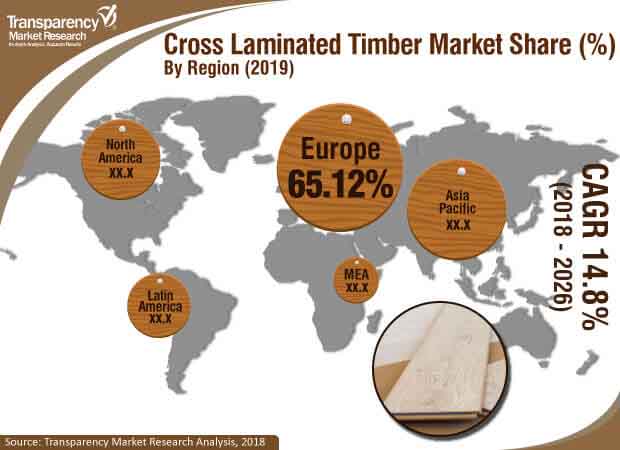Understanding Impact of COVID-19 on Cross-laminated Timber Market
Cross-laminated Timber Market: Snapshot
The global cross-laminated timber market is all set to gather handsome amount in the form of revenues during the forthcoming years. Key reason for this growth is increased demand for cross-laminated timber from various end-use industries including construction sector. In recent years, cross-laminated timbers are widely used in the construction of residential buildings, educational institutes, government/public buildings, and industrial and commercial spaces. This factor is stimulating the growth of the global cross-laminated timber market.
Cross-laminated timber can be defined as a wood panel product manufactured by sticking together layers of lumber that is cut from a single log. Every layer of board is generally adjusted perpendicular to adjoining layers. Then these layers are glued on the wide faces of every board in a symmetric way. As a result, the outer layers of panel offer the identical orientation. Similarly, by gluing wood layers at right angles, the panel gets superior structural rigidity in both directions.
Generally, the cross-laminated timer holds odd number of layers. The number of layers can be added as per the need of end-user. Thus, this design flexibility is one of the key reasons owing to which the vendors working in cross-laminated timber market are gaining remarkable demand avenues. As cross-laminated timer is manufactured using multiple layers of wood, its thermal insulation can be high dependent on the panel thickness.
Enquiry Before Buying:https://www.transparencymarketresearch.com/sample/sample.php?flag=EB&rep_id=51738
Cross-laminated timber is gaining traction owing to its eco-friendly nature. This product uses green, renewable, and sustainable material. Use of cross-laminated timber can allows for prefabrication. Owing to this facility, the walls or floors made with cross-laminated timber can be manufactured before reaching to the actual construction site. This helps in minimizing the lead times, and thereby overall construction cost of project is reduced to some extent. Owing to this factor, the products from the global cross-laminated timber market are widely used in construction sector.
Cross-laminated Timber Market – Snapshot
Cross-laminated timber (CLT) is also known as X-lam or massive timber. It is a prefabricated engineered wood panel made of three to four layers of solid-sawn lumber or composite lumber. Composite lumber is well-laminated through gluing of longitudinal and transverse layers by using structural adhesives to form solid, rectangle-shaped, straight, and plane timber. Cross-laminated timber was first developed and used in Germany and Austria in the early 1990s. Extensive research on the product was conducted in the mid-1990s.
Buy Now :https://www.transparencymarketresearch.com/checkout.php?rep_id=51738<ype=S
By the 2000s, cross-laminated timber was being used much widely in Europe, in single-storied as well as multi-storied buildings. Cross-laminated timber is still a new concept. There is little specific technical documentation for the erection of structures designed and built with it. In most parts of the world, concrete and steel are largely used. Producers of cross-laminated timber are unable to compete with steel and concrete in case of high-rise buildings. Certain governments have restricted the use of wood as a structural material to construct high-rise buildings. In the U.S., the International Building Code (IBC) limits the usage of wood to four stories.

Explore Transparency Market Research’s award-winning coverage of the global Industry:https://www.prnewswire.com/news-releases/increasing-research-and-development-to-underscore-growth-in-levulinic-acid-market-from-2019-to-2027-tmr-301114789.html
Based on type, the global cross-laminated timber market has been segmented into adhesive-bonded cross-laminated timber and mechanically fastened cross-laminated timber. Both the segments are anticipated to expand at a rapid pace during the forecast period. Adhesive-bonded Cross-laminated timber is the more widely used type than mechanically fastened cross-laminated timber. Despite being more expensive as compared to mechanically fastened cross-laminated timber, adhesive-bonded cross-laminated timber is widely used due to its superior properties. Mechanically fastened cross-laminated timber helps in reducing the cost of manufacture of cross-laminated timber. Mechanically fastened cross-laminated timber systems can be produced economically and they can be utilized to attain structurally sound construction. This is projected to create opportunities for small-sized cross-laminated timber production facilities in the near future.
In terms of application, the global cross-laminated timber market has been segmented into residential buildings, educational institutes, government/public buildings, and industrial & commercial spaces. Residential buildings is a prominent segment of the cross-laminated timber market. In residential buildings, cross-laminated timber is used in walls, roofs, and ceilings. Flooring and walls made from cross-laminated timber can be assembled fully before reaching the project site. This prefabrication helps in decreasing the construction time and cost. Cross-laminated timber is less commonly used in the construction of industrial and commercial spaces. They require strict building codes of strength to be followed. However, some U.S.-based companies produce cross-laminated timber panels for temporary roads and working platforms for use in the oil & gas and heavy construction industries. Educational Institutes is estimated to be a rapidly expanding segment of the cross-laminated timber market over the forecast period.
About Us :
Transparency Market Research is a global market intelligence company, providing global business information reports and services. Our exclusive blend of quantitative forecasting and trends analysis provides forward-looking insight for thousands of decision makers. Our experienced team of Analysts, Researchers, and Consultants, use proprietary data sources and various tools and techniques to gather, and analyze information.
Our data repository is continuously updated and revised by a team of research experts, so that it always reflects the latest trends and information. With a broad research and analysis capability, Transparency Market Research employs rigorous primary and secondary research techniques in developing distinctive data sets and research material for business reports.
Comments
Post a Comment